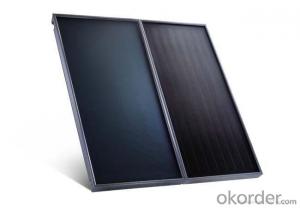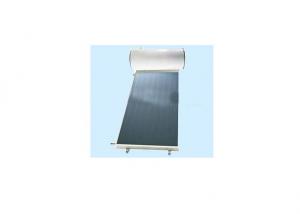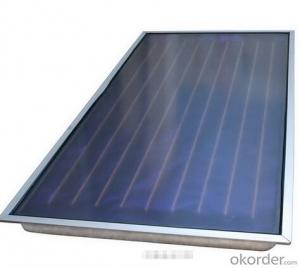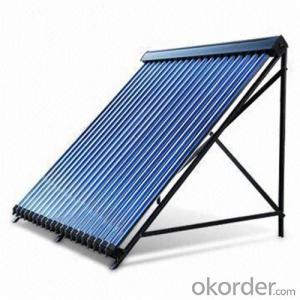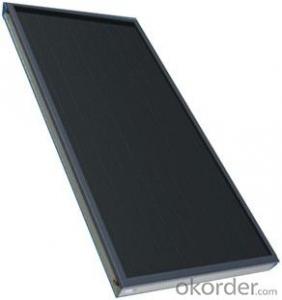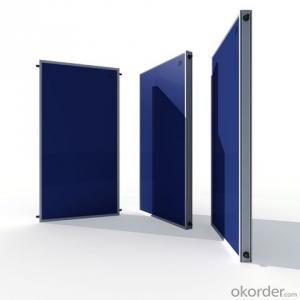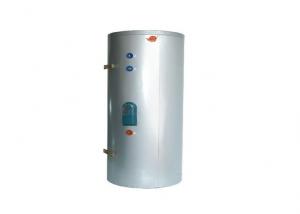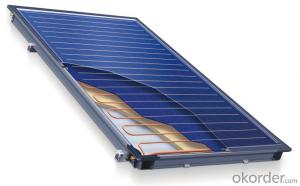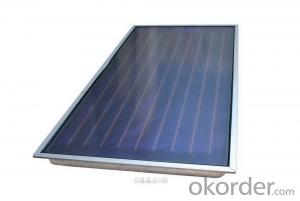Solar Thermal Application and Glass Pipe Material solar thermal collector
- Loading Port:
- Shanghai
- Payment Terms:
- TT OR LC
- Min Order Qty:
- 500 pc
- Supply Capability:
- 10000 pc/month
OKorder Service Pledge
OKorder Financial Service
You Might Also Like
Specification of flat plate solar collector:
1) Low iron textured tempered glass(3.2mm thickness)offers the best capability of durability, strength.
2) Tinox blue titanium or black chrome coating have very high absoption rate to ensure the high efficiency.
3) Whole-plate ultrasonic welding technology makes the flate plate solar collector more beautiful, efficient and durable.
4) Special Anodized aluminum alloy frame to ensure handsome appearance and can accept high pressure without leakage.
These top-of-the-range solar panel heat collectors are suitable for heating domestic hot water, swimming pools etc - even in winter! One unit is adequate for an average household (3-4people), and it is modular, so you can add more if required. A single panel is sufficient for a 200litre cylinder, but you can fit 2 or more for high water usage, or for heating swimming pools or underfloor heating. Some types of renewable energy are only available in certain locations, however free solar heating is potentially available to almost every house in the world! "
Specification of flat panel solar collector
Flat plate collectors are an extension of the basic idea to place a collector in an 'oven'-like box. Here, a pipe is connected to the water tank and the water is circulated through this pipe and back into the tank. The water tank is now outside the collector that only contains the pipes. Since the surface-to-volume ratio increases sharply as the diameter of a pipe decreases, most flat-plate collectors have pipes less than 1 cm in diameter. The efficiency of the heating process is therefore sharply increased. The design of a flat-plate collector therefore typically takes the shape of a flat box with a robust glass top oriented towards the sun, enclosing a network of piping. In many flat-plate collectors the metal surface of the pipe is increased with flat metal flanges or even a large, flat metal plate to which the pipes are connected. Since the water in a flat-plate collector usually reaches temperatures much higher than that of an ICS, the problem of radiation of heat back to the environment is very important, even though a box-like 'oven' is used.
Description:
Flat-plate collector is one of common solar collectors for solar hot water heating in homes and solar space heatings. Flat plate solar collectors provide quality hot water with its new solar energy efficient flat plate design. This glazed collector includes a selective coating to maximize the solar heat absorption, weather resistant aluminium framing and interior fibreglass insulation for increased efficiency.
Features:
1) High efficiency solar collector using heat pipe evacuated tubes
2) Able to be used in all climates
3) Reliable and efficient with twin-glass solar tubes
4) Copper heat pipes for rapid heat transfer
5) Easy plug-in installation for mounting on the roof or at ground level
6) Maintenance free
7) Suitable for mains pressure water (up to 6bar / 87psi)
8) Corrosion resistant silver brazed copper header
9) Frame material: 304 2B grade standard steel
10) Casing material: 304 BA or AB stainless steel
11) Excellent insulator in glass wool
12) Collectors may be connected in series to increase water heating capacity
13) Tubes easily replaced if broken - can be used with broken tubes
14) Ideal for commercial solar water heating applications
- Q:Can solar collectors be used for heating swimming pools in colder climates?
- Yes, solar collectors can be used for heating swimming pools in colder climates. Solar collectors harness the energy from the sun to heat water, and even in colder climates, they can effectively raise the temperature of pool water. While colder climates may affect the efficiency of solar collectors to some extent, with the right system design and size, solar collectors can still provide significant heating for swimming pools.
- Q:How do solar collectors perform in windy conditions?
- Solar collectors can be affected by strong winds, as they can cause the panels to vibrate and potentially damage the system. Additionally, gusty winds can reduce the efficiency of solar collectors by cooling down the panels and increasing heat loss. However, modern solar collectors are designed to withstand a certain degree of wind load and are equipped with measures to minimize any negative impact from windy conditions. Proper installation and regular maintenance can help ensure the optimal performance of solar collectors even in windy conditions.
- Q:Can solar collectors be used for heating airports?
- Yes, solar collectors can be used for heating airports. Solar thermal systems can be installed to provide heat for various purposes in airports, including heating water, space heating, and even heating the runway to melt snow and ice. This can help reduce energy consumption and greenhouse gas emissions, making airports more sustainable and environmentally friendly.
- Q:Can solar collectors be used for generating electricity on airports?
- Yes, solar collectors can be used for generating electricity on airports. Solar panels can be installed on rooftops, parking lots, or unused land at airports to harness solar energy and generate electricity. This renewable energy source can help airports reduce their carbon footprint, decrease reliance on fossil fuels, and contribute to a greener and more sustainable operation. Additionally, solar power can provide a reliable and cost-effective energy solution for powering various airport facilities and operations.
- Q:Can solar collectors be used for generating electricity on beaches?
- Generating electricity on beaches can be achieved through the use of solar collectors, also known as solar panels. These panels convert sunlight into electricity by utilizing the photovoltaic effect. The sunlight excites electrons in the photovoltaic cells, resulting in a flow of direct current (DC) electricity. This DC electricity can then be converted into alternating current (AC) electricity, which is suitable for powering different electrical devices. Beaches, being exposed to ample sunlight, are ideal locations for harnessing solar energy. Installing solar panels on beaches allows for the generation of clean and sustainable electricity, which can be used to power beach facilities like lighting, water pumps, and even charging stations for mobile devices. Solar energy is renewable and abundant, making it an environmentally friendly choice for beach destinations. Moreover, the utilization of solar collectors on beaches can help reduce our reliance on fossil fuels and contribute to the decrease of carbon emissions. It represents a step towards promoting green energy and sustainable practices in coastal areas. However, it is essential to consider factors such as the orientation and tilt of the solar panels to maximize energy production, as well as the potential impact on the beach ecosystem and aesthetics. In summary, solar collectors can undoubtedly be employed for generating electricity on beaches. They provide a clean and renewable energy source, which can power various beach facilities and contribute to a more sustainable future.
- Q:Can solar collectors be used for generating electricity on warehouses?
- Yes, solar collectors can be used for generating electricity on warehouses. Solar collectors, also known as solar panels, can be installed on the rooftop of warehouses to harness sunlight and convert it into electricity. These panels are made up of photovoltaic cells that absorb sunlight and generate direct current (DC) electricity. This DC electricity is then converted into alternating current (AC) electricity through an inverter, which can be used to power the electrical systems within the warehouse or even feed excess electricity back into the grid. Solar collectors are a sustainable and environmentally-friendly way of generating electricity, as they rely on renewable energy sources and produce zero greenhouse gas emissions. Additionally, installing solar collectors on warehouses can help businesses reduce their dependence on fossil fuels, lower their electricity bills, and contribute to a cleaner energy future.
- Q:Can solar collectors be used for heating electronics manufacturing plants?
- Yes, solar collectors can be used for heating electronics manufacturing plants. Solar thermal systems can be integrated into the heating systems of these plants to provide a renewable and sustainable source of heat. This can help reduce the reliance on fossil fuels and decrease the carbon footprint of the manufacturing process.
- Q:Are there any drawbacks to using solar collectors?
- Yes, there are a few drawbacks to using solar collectors. Firstly, solar collectors are dependent on sunlight, so they may not be as efficient in areas with limited sunshine or during cloudy days. Secondly, the initial installation cost of solar collectors can be high, although the long-term savings on energy bills can offset this. Additionally, solar collectors require a significant amount of space for installation, which may not be feasible for all properties. Lastly, the production and disposal of solar panels can have some environmental impacts, although they are generally considered much less harmful than traditional energy sources.
- Q:Can solar collectors be used in areas with limited skilled labor?
- Yes, solar collectors can be used in areas with limited skilled labor. Solar collectors are relatively simple to install and maintain, requiring basic technical knowledge. Additionally, many manufacturers provide training and resources to support the installation and maintenance process. Furthermore, there are organizations and initiatives aimed at promoting solar energy in developing regions, which often include capacity-building programs to train local individuals in the necessary skills.
- Q:Can solar collectors be used for heating oil refineries?
- Yes, solar collectors can be used for heating oil refineries. Solar thermal technology can provide heat for various industrial processes, including oil refineries. Solar collectors capture sunlight and convert it into thermal energy, which can be used to generate steam or heat fluids. This renewable energy source can help reduce the reliance on fossil fuels and lower operating costs for oil refineries while reducing their carbon footprint.
1. Manufacturer Overview |
|
|---|---|
| Location | |
| Year Established | |
| Annual Output Value | |
| Main Markets | |
| Company Certifications | |
2. Manufacturer Certificates |
|
|---|---|
| a) Certification Name | |
| Range | |
| Reference | |
| Validity Period | |
3. Manufacturer Capability |
|
|---|---|
| a)Trade Capacity | |
| Nearest Port | |
| Export Percentage | |
| No.of Employees in Trade Department | |
| Language Spoken: | |
| b)Factory Information | |
| Factory Size: | |
| No. of Production Lines | |
| Contract Manufacturing | |
| Product Price Range | |
Send your message to us
Solar Thermal Application and Glass Pipe Material solar thermal collector
- Loading Port:
- Shanghai
- Payment Terms:
- TT OR LC
- Min Order Qty:
- 500 pc
- Supply Capability:
- 10000 pc/month
OKorder Service Pledge
OKorder Financial Service
Similar products
New products
Hot products
Hot Searches
Related keywords
